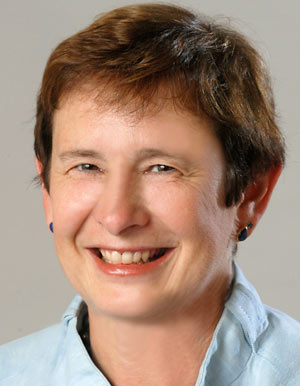Campus expands course offerings
Campus leaders announced Monday that more than half a million dollars will be allotted to expand foreign language course offerings in 2011-12, part of a larger effort to increase student access to vital classes.

February 15, 2011
University of California, Berkeley, students seeking to enroll in basic foreign language courses may soon find it easier to get into the courses of their choosing.
Campus leaders announced publicly today (Tuesday, Feb. 15) that more than half a million dollars will be allotted to numerous foreign language courses beginning in 2011-12 and will ultimately result in more than 30 additional language courses offered.
The funding, announced by Chancellor Robert Birgeneau and George Breslauer, executive vice chancellor and provost, is part of a larger campus effort to ensure that even during these difficult budgetary times, students have access to key undergraduate courses that are often overenrolled.

Catherine Koshland, task force co-chair. Photo by Peg Skorpinski
By 2011-12, more than $6.25 million will have been allocated toward this effort. Previously, the campus provided funds for additional reading and composition (R & C) courses, as well as for additional lower-division math and science courses. Annual funding to address enrollment demands will continue thereafter.
“The chancellor and I place high priority on using some of the undergraduate fee increases, as well as some of the extra revenue generated by increasing out-of-state and international student enrollment, to protect and enhance the quality of undergraduate instruction,” Breslauer wrote in a letter sent to the campus community Monday evening.
“It reflects our commitment during these difficult budgetary times to protect quality and excellence on the academic side,” he wrote, “while promoting efficiency and seeking cost-savings in non-academic areas.”
In 2010-11, the campus added more than 1,000 enrollment seats for R&C courses. In spring 2011, the campus added an additional 600 enrollment seats for math/science lower division courses in chemistry, math, physics and statistics.
Campus data show that despite budget cuts, UC Berkeley has made gains in its effort to keep up with student demand for critical courses. Although final data are not yet available for spring 2011, projected data for the 2010-11 academic year show that, campus-wide, course offerings have increased at the lower-division level for both primary courses (by more than 100) and secondary “discussion” sections (by more than 50). The course expansion effort for R&C courses and for math/science lower division courses contributed to this overall increase in course availability, according to campus officials. They also noted, however, that there will always be individual students who will not get into the courses of their choosing.
Since fall 2009 the UC Berkeley Division of the Academic Senate and an administrative task force had been studying the broad issue of course overcrowding and critically needed courses, and providing its recommendations to the chancellor and provost. The final recommendation regarding the expansion of foreign language programs completes the task force’s assignment.
The task force work guided campus leaders in deciding where funds to support classroom instruction should go, according to Catherine Koshland, co-chair of the task force and vice provost for teaching, learning, academic planning and facilities.
“We identified the most critical areas of the curriculum that served the broad student community, the ‘common good,’ where demand was simply not being met,” said Koshland. “These courses are critical to our students’ intellectual development and academic success, and also to their long-term success beyond Cal. We owe it to them to ensure timely access to these important courses.”
Such courses are of vital importance to students across many disciplines, not just to students in a particular major. Among foreign language offerings, for example, only five percent of students taking those courses are majoring in those languages. Others who take the courses include student journalists, graduate students and others students who seek a deeper understanding of their family and cultural backgrounds. The task force members also noted the importance of foreign language courses in today’s increasingly global society. They urged the campus not to follow the lead of other public universities that had cut such offerings in face of budget restrictions.
Members on the task force evaluated enrollment trends, student demand for courses, and others factors in determining which language programs would receive funding and how much. Those that will receive funding include Arabic, Chinese, French, German, Hindi, Italian, Japanese, Korean, Persian, Portuguese, Russian, Spanish, Tagalog and Vietnamese. The campus has also committed additional support for African language instruction in conjunction with a Title VI grant awarded this year. The Berkeley Language Center, which provides language laboratories and equipment to students and instructors involved in the language programs, will also receive funding.